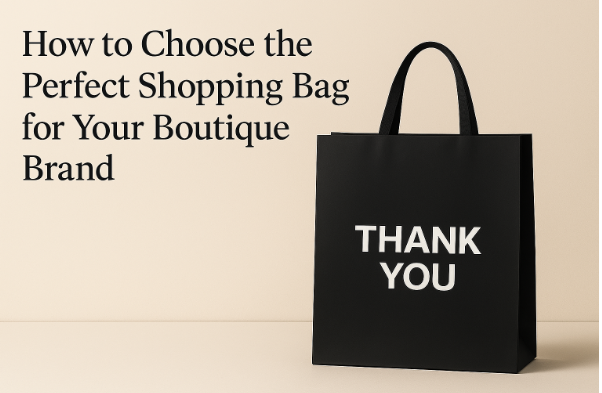If you run a boutique—whether fashion, accessories, craft, or gift—you know that customer experience is woven into every detail. The bag you hand over at checkout is one of the final tactile impressions your customer gets. A good shopping bag does more than carry: it protects, reinforces your brand, and even becomes a silent advertisement when carried outside your store.
Below, we explore what makes a “perfect” shopping bag, how to assess your needs, and examples of bag types (with reference to a real collection) to inspire your selection.
Why the Right Shopping Bag Matters
Think of your shopping bag as both utility and branding. A bag that tears, feels cheap, or looks generic hurts perception; conversely, a well-designed, durable bag adds perceived value to the purchase. It signals that you care about presentation, not just profit.
A sturdy, attractive bag:
- Protects the product during transport
- Makes carrying easier for the customer
- Reflects your brand identity (colors, logos, style)
- Can be reused or shown off in public, increasing exposure
So the right bag isn’t just an afterthought—it’s part of your brand toolkit.
Key Criteria for Selecting a Boutique Shopping Bag
When choosing, think about these dimensions (literal and conceptual):
Material & Strength
Lightweight bags may seem cheaper, but they fail when overloaded. Many boutique bags are made of LDPE (low-density polyethylene) with thickness measured in mils (thousandths of an inch). In the InfinitePack collection, many shopping bags are offered in 2.35 mil or 3 mil variants to ensure durability under load.
Handle Type & Comfort
The way a bag is carried affects customer comfort. InfinitePack offers die-cut handles (a portion cut from the bag itself) and loop handles (soft loops attached). Loop handles tend to feel more refined and comfortable, especially when the load is heavier. Die-cut handles are more minimal but risk tearing if the bag is overfilled.
Size & Proportional Fit
A bag too large for the product feels wasteful; too small leads to overstuffing or crumpling. The InfinitePack offering includes a variety of sizes—9 × 12, 12 × 15, 16 × 18, 20 × 15, etc.—and some with bottom gussets (a fold at the bottom) to allow for more bulk.
Style & Print / Branding Options
A blank, plain bag is basic. But a well-printed logo, brand colors, or pattern can turn your bag into a mini marketing piece. InfinitePack includes “Thank You” printed merchandise bags and boutique shopping bags with loop handles, which subtly combine branding with function. Ensure your print is crisp, and the ink or print method is compatible with handling (resistant to scratches, smudges).
Transparency vs Opaque
Clear (transparent) bags let the product show through — good for fashion boutiques, gift shops, or brands that want the product to be visible from the moment it’s bagged. InfinitePack sells clear shopping bags and clear poly bags with die-cut handles. Opaque or colored bags offer more “surprise” and brand control (you choose what the outside looks like).
Gussets & Capacity Expansion
Bags with bottom or side gussets allow for more depth, so the bag can expand to fit bulkier items. Some of the boutique/loop-handle bags in the InfinitePack catalog come with a 6″ bottom gusset design. If you sometimes sell items with volume (shoes, layered clothing), that flexibility helps.
Real-Example Bag Types from the Collection
Below are a few representative examples to help you visualize choices. (I’ve cited them as product-style references, not endorsements.)
- InfinitePack 18″ × 18″ Christmas Gift Bag — A larger square bag with loop handle, suited when sales include gift-size items or you want a more festive, premium option for holiday lines.
- InfinitePack 400‑ct Combo Poly Bag Set — A mix of sizes, useful to test which sizes your customers use most before committing to bulk order.
- Infinity My Clear Bag Flower Red — A transparent/red-accented bag with visible product inside — ideal when your items are visually strong (e.g., printed garments, jewelry).
Use these examples as inspiration for what dimensions, handle styles, or transparency levels could look like in your boutique.
Steps to Pick the Right Bag Strategy
Here’s a process you can follow to land on (or refine) your bag decision:
- Audit Your Orders
Check your last 100 orders: what are the dimensions and volumes of the most commonly sold items? Try physically simulating them in candidate bags. - Choose Primary & Secondary Sizes
Many boutiques get one “main” bag size and one secondary (e.g. for large orders). Don’t over-diversify; stocking too many types complicates inventory. - Order Samples & Stress Test
Buy low-quantity samples of several styles and mil ratings. Fill them, hand them to staff or mock customers, carry them around. See what fails or feels awkward. - Design & Branding Mockups
Get mock-ups (digital or printed) showing your logo and colors. Check how branding looks when folded, crumpled, or carried. - Plan for Inventory & Turnover
Bags don’t last forever — edges wrinkle, prints fade. Rotate your stock, order fresh when needed. - Monitor Customer Feedback & Behavior
Watch for tear incidents, social media photos, or informal comments (“nice bag!”). Also see if customers reuse or ask about your bag.
Final Thought
Your boutique’s bag is more than a carrier — it’s a physical handshake with your customer. The perfect bag balances utility, robustness, aesthetic alignment, and subtle marketing power. By carefully evaluating material, size, handle style, and branding, you turn that final handoff into a moment of delight — and a silent invitation to return.
